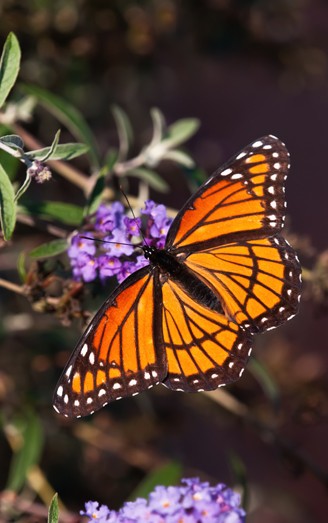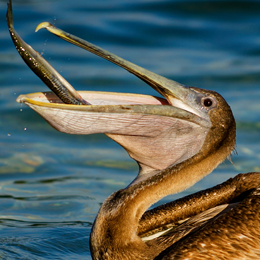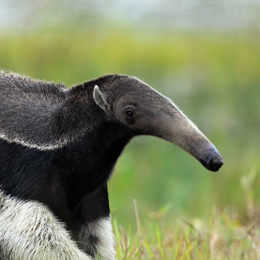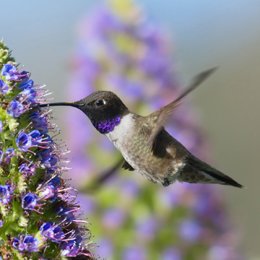Description
The Viceroy butterfly, scientifically known as the Limenitis Archippus, is a species from the largest family of butterflies, known as Nymphalidae. This family consists of over 6000 species of butterflies, scattered all across the world.
The Viceroy butterfly got its name due to its appearance, which is very similar to a larger species known as the monarch butterfly. It was long believed that the Limenitis Archippus was mimicking the more powerful Monarch, and thus the name, “Viceroy”.
The black stripes on the bright orange viceroy butterflies’ wings are actually veins, connecting with each other at the bottom of the hindwing. Their appearance and size are very similar to monarch butterflies, but the latter lacks a black horizontal marking on its second pair of wings.
Viceroy butterflies are a little smaller than monarch butterflies. It can grow up to a wingspan of 6 to 8 centimeters in its lifetime and weight up to 0.65 grams.
There is little to no visible differences between the male and female viceroy butterflies. However, when seen together the larger size of the female can be noticed easily.
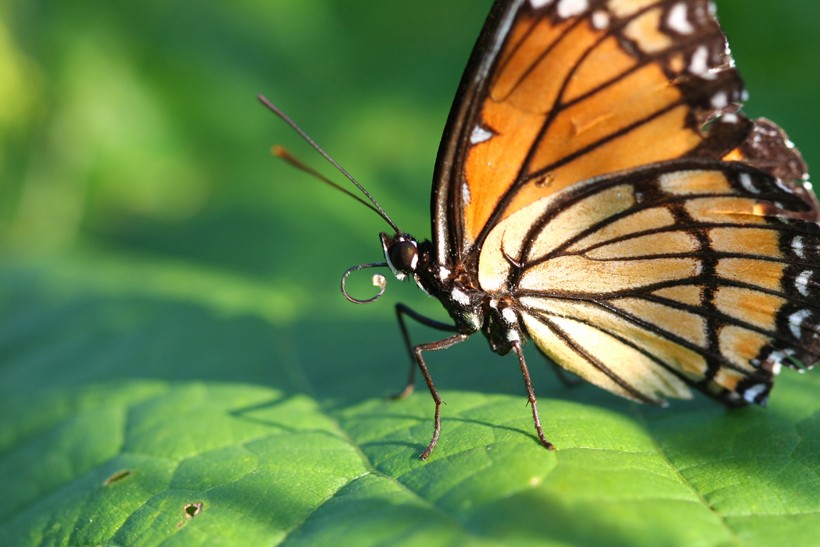
The viceroy butterfly smell with its feet and antennae
?
Image credits: Ron Rowan Photography/Shutterstock
Viceroy butterflies are deaf like most insects, but they do a have a unique set of sensory organs enabling it to understand its surroundings well.
Like most butterflies, the viceroy has compound eyes consisting of numerous lenses. This allows the butterfly to see multiple directions at the same time.
Their eyes are particularly sensitive to color, movement and light. They can also detect ultraviolet light radiated from different flowers and vegetation. Their incredible eyes are assisted by sensitive feet, antennae and a proboscis. Their feet and antennae have unique sensory organs that can detect smell. When it sits on a flower, its sensory system allows it to figure out whether the flower has nectar to feed on.
It can also be seen touching the ground and the surroundings with its antennae repeatedly to check for nutrients in the soil.
Males use these senses to detect food and mates while the female may also use its senses to find an ideal site for laying eggs.
Habitat
The viceroy butterfly prefers shrubby habitat, usually found nearby a water source or swamp land. They are found mainly in North America and in parts of Mexico and Southern Canada. They are diurnal with complete activity during the day time.
Adult viceroy butterflies feed on nectar from flowers and can be often found on milkweed and thistles. Caterpillars of the viceroy eat leaves of trees and shrubs like willows and cottonwood.
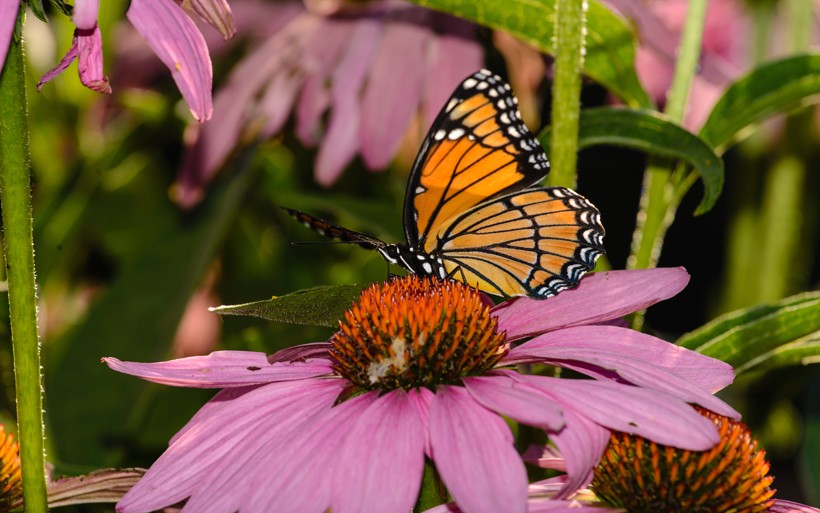
The adult viceroy feeds on nectar
?
Image credits: John E Heintz Jr/Shutterstock
Viceroy butterflies live in a habitat filled with predators; birds, frogs, spiders and small snakes can easily prey on a viceroy butterfly in the shrubs.
However, the viceroy is not completely defenceless. The cottonwood and willow diet of the caterpillars make the adult unpalatable for most of its predators. It also uses its bright orange color to warn the predators about its upsetting feature.
They are spread across the North American continent by adapting according to the local conditions and thus on a longer term forming subspecies.
Identification of Subspecies
Limenitis Archippus are distributed in 6 known subspecies. Based on the surroundings and locations, the subspecies show slight differences in their color and appearances. The subspecies are:
- Limenitis A. Archippus: It is also known as the Eastern Viceroy. It is the dominate subspecies found in North America and Canada. Their appearance is quite similar to the monarch butterflies. They have a smooth black line across the hindwing and black veins across its bright orange colored wings.
- Limenitis A. Obsoleta: Also known as the Arizona Viceroy, this subspecies is found mainly in Arizona and in parts of California and Utah. The black lining on the hind wing is a little edgy with small white spots along the line. Out of all the viceroy subspecies, the Limenitis A. Obsoleta population faces tremendous habitat loss due to human activity in the viceroy butterfly range.
- Limenitis A. Lahontani: These are paler in color and are found mainly in Utah and Northeastern Nevada. Hence, they are also widely known as the Nevada Viceroy.
- Limenitis A. Floridensis: L. A. Floridensis or the Florida Viceroy is spread throughout Florida and Southern Georgia. Its wings are darker and it can grow larger than the eastern viceroy. Its physical appearance closely resembles the Queen butterfly; but unlike the Queen, the viceroy has a black line on its hind wings.
- Limenitis A. Hoffmanni: It is found in Mexico, and is the only subspecies that completely lacks the black line on its hind wings. Its appearance resembles the Soldier butterfly, which is a close relative to the Monarch and Queen butterflies.
- Limenitis Archippus Watsoni: This subspecies is also known as Watson’s Gulf Coast Viceroy. Their only visible physical difference is that their forewings are slightly darker than the hind wings.
Reproduction and Life Cycle
For most butterflies the life span is approximately 12 months, out of which they spend 8-10 months, developing as a caterpillar.
Adult viceroy butterflies can live for up to 3-4 weeks after they emerge from the chrysalides in the spring season. Viceroy butterflies can give rise to 2-3 generations in a breeding season. Mating occurs in late mornings and afternoons. During mating season, the male looks for females for mating.
They use a unique tail-to-tail mating style, where both individuals are connected by their tails. They can also fly in this circumstance.
The larger female can be often seen towing the smaller male around the shrubs.
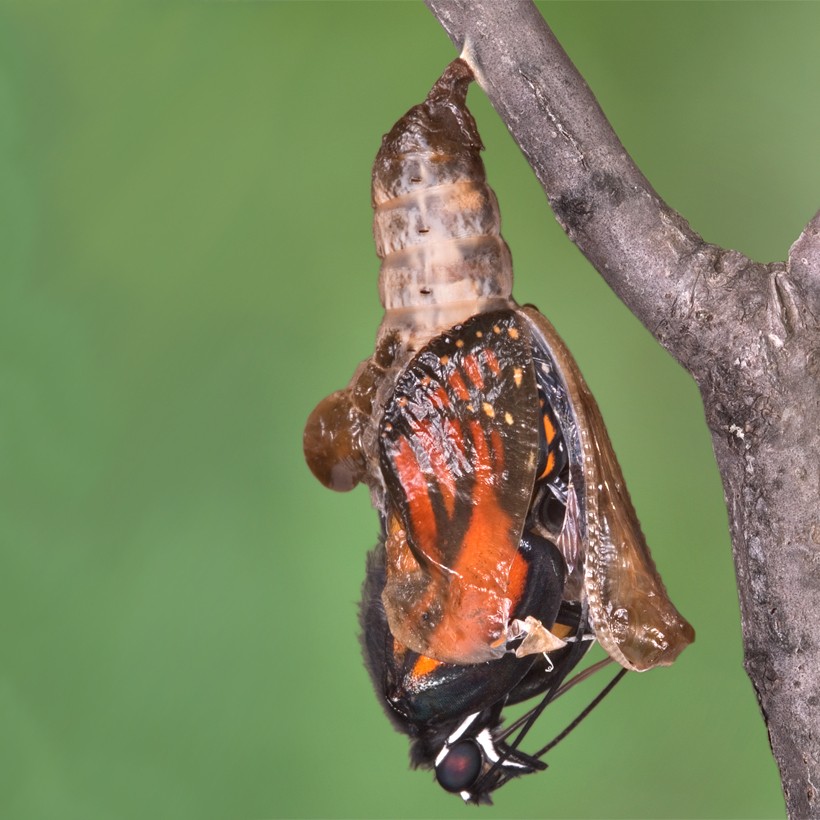
Viceroy emerging from the chrysalis
?
Image credits: Cathy Keifer/Shutterstock
Within a few days, the female lays pale green colored eggs on the tip of the leaves from a host plant. A female can lay up to 2-3 eggs per plant to ensure the survival of her offspring.
As soon as the caterpillar emerges it perches on the host plant and feeds on its leaves. During winter, the caterpillar rolls the leaf of the host plant and hibernates inside it.
Most of the growth is seen during spring, as the caterpillar completes the remaining instars and the chrysalis stage in this season.
The chrysalis stage takes up to 10 days, after which the caterpillar emerges out as an adult viceroy butterfly.
The viceroy is also known to rarely form natural hybrids with the red-spotted purple butterfly, scientifically known as Limenitis Astyanax. The hybrid species is named Limenitis Rubidus. It shares combined characteristics of both the viceroy and the red-spotted purple.
The orange wings and black veins are clearly visible on the ventral side, but the butterfly appears to have a purple coating over the orange-black wings when observed dorsally.
No parental care is practiced in viceroy butterflies, even though the caterpillars share their habitat with numerous predators. So, they use unique mimicking strategies to survive and flourish.
Defensive Mimicry
At all stages, the viceroy exhibits a mimicking behavior to avoid predators.
The eggs of the viceroy resemble insect galls to deceive predators. The hatched viceroy caterpillars resemble bird droppings and also secrete salicylic acid, which makes them bitter in taste and upsetting to the predator’s stomach. Due to their appearance and taste, most predators avoid the caterpillar, allowing it to grow into an adult butterfly.

Caterpillar viceroy
?
Image credits: Tyler Fox/Shutterstock
An adult viceroy butterfly exhibits a further complex form of defensive mimicry. This behavior of the viceroy is yet to be understood completely.
The viceroy butterfly exhibits physical resemblance to three species of genus Danaus. The physical appearance of the viceroy butterfly changes dramatically according to the species with which it shares their habitat.
Monarch, Queen and Soldier are the three closely related butterflies that share its physical characteristics with the viceroy.
For a long time it believed that the viceroy is not at all harmful to its predators, and so it mimics unpalatable butterflies like the Monarch and the Queen.
On the basis of this conclusion, early biologists believed that the behavior can be termed as Batesian mimicry, where one harmless species mimics the other harmful one to deceive the predators.
However, later studies conducted extensively on the queen, monarch butterfly and viceroy butterfly, gave contradictory conclusions.
Researchers found that the viceroy butterfly itself is quite unpalatable to its predators, and the mimicking behavior cannot be termed as Batesian as none of the butterflies were dependant parasitically on each other.
Based on this, biologists suggested that viceroy butterfly mimicry is a better example of Müllerian mimicry, where different species with similar needs, mimic each other for easier survival. Simply, any bird that has once tasted a monarch, queen or viceroy, tends to avoid all butterflies with similar appearances.
Behavior and Intelligence
Viceroy butterflies are solitary diurnal creatures that are active only in the late mornings and afternoons. They use a typical perch and patrol behavior, in order to find food and females in its territory.
During the day time a male can be seen flying for up to 20 metres and then resting on low vegetation or on the ground. This viceroy butterfly behavior allows them to hold a larger territory despite their small size.
In mating season, a male can mate multiple times in an effort to ensure the survival of his genes.
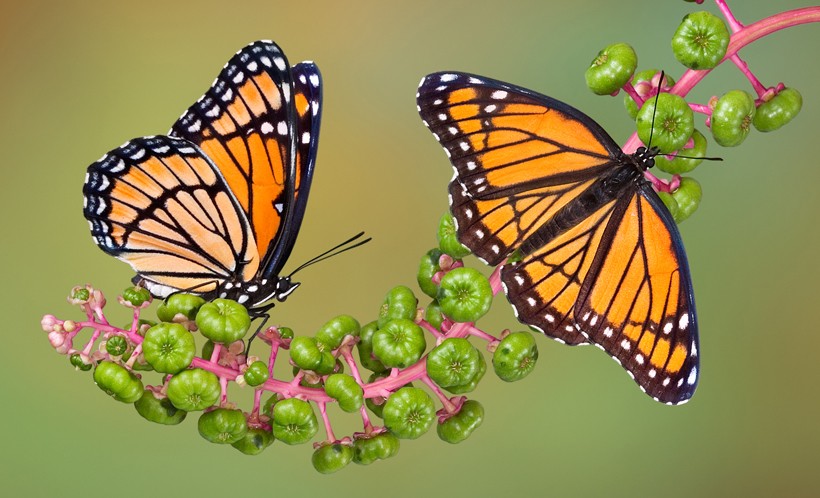
Viceroy butterflies are territorial; a male doesn't allow another male in its area
?
Image credits: Cathy Keifer/Shutterstock
When active, the viceroy butterfly constantly perches and patrols its area back and forth. They are known to be territorial creatures, and a male doesn’t tolerate another male in its area. When two males confront each other, they fly rapidly up and down up to 50 metres in order to push each other out of the territory.
The female is more subtle and can be seen feeding most of the time. The female scans the territory constantly for good sources of food and appropriate sites to lay eggs.
Due to their unique and deceiving mimicking behavior and capability of forming natural hybrids, viceroy butterflies have long been studied by biologists around the world.
The species is genetically quite intelligent as it uses many deceiving ways to survive. It also has a good idea about its territory despite the small size.
The females carefully select the plants that are not at all infected by other insects, so that the caterpillars can have a safe start.
These features indicate that the viceroy can be more intelligent than other butterflies of the same size. However, no communication is observed between the individuals of same species.
Population and Conservation
Viceroy butterflies occupy most of the North American continent. They are found in Arizona, Utah, California, Florida, Georgia and surrounding states of North America. They also occupy shrub-lands of Southern Canada and Northern Mexico.
Due to their mimicking behavior and survival strategies, almost all subspecies of the viceroy are considered stable. However, increased human activity is causing loss of their habitat with an increased rate of loss over the last decade.
The population of subspecies Limenitis A. Obsoleta has largely dropped in numbers over the last few years. Biologists speculate that though the numbers are stable for now, all subspecies of the viceroy may run under threat in the near future.
The primary cause for the drop in numbers is pointed out to be habitat loss. Shrubs and bushes are often considered useless by locals and cleared-up for agricultural and constructional purposes, resulting in loss of feeding and breeding sites for butterflies.
No conservation methods have been applied yet, as there are good numbers of viceroys when seen as one species. However, it is speculated that replenishing their habitat can easily improve the situation for the subspecies under threat.
Evolution
A unique part of the evolution of the viceroy is its mimetic behavior. The species tends to have a great ability to appear other organisms in its habitat.
Mimetic behavior in the wild is triggered usually by predation and availability of toxic unpalatable organisms. It is speculated that the viceroy must have evolved this ability at times when there were numerous unpalatable beings in its surroundings.
Over the years of its evolution, it gradually gained very close resemblance to the model species.
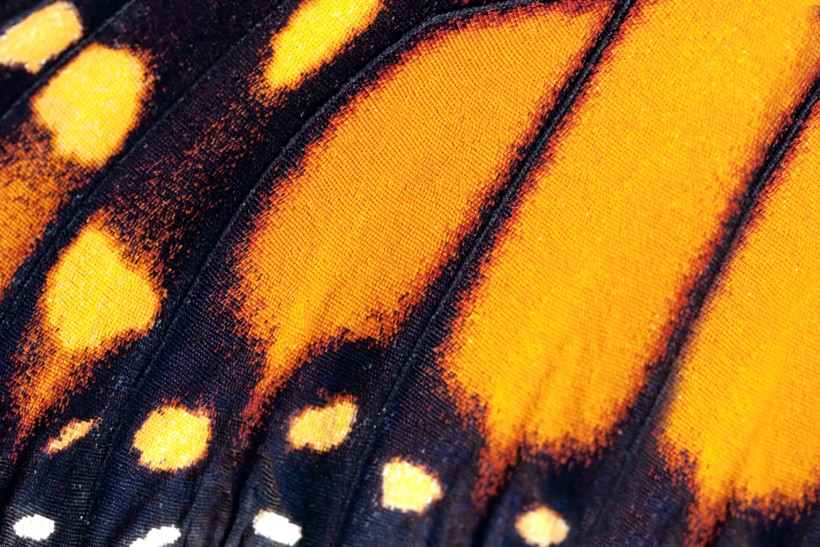
The Viceroy, Monarch and Queen butterflies mimic eachother for easier survival
?
Image credits: Peter Waters/Shutterstock
However, the evolution of same orange-black color in many species of butterfly like the monarch, queen, viceroy and soldier, must be due to the process called natural selection.
Natural selection is when a species evolves certain strengths on the basis of their success rate in previous generations. The certain pattern and color of viceroys got avoided frequently by predators, causing them to survive and reproduce more.
Eventually, after years of evolution, the species developed a perfect blend of color and appearance to protect itself from its predators.
Fossils
Fossil records of insects like butterflies and moths have allowed us to largely understand the formation of the earth and its other beings.
It is speculated that the first insects may have appeared on the phase of earth approximately 350 million years ago.
The earliest known fossil of the butterfly was found in North America and was estimated to be approximately 40-50 million years old. The well-preserved fossil provided valuable information on the development of butterflies.
The butterfly was named Prodryas Persephone and was classified under the large family Nymphalidae which also consists the modern butterflies like the viceroy and monarch.
Funfacts
- The name “Viceroy” was given to it due to its mimetic relationship with three other species named as Monarch, Queen and Soldier.
- The viceroy butterfly is unpalatable and is known to upset the stomach of its predators.
- Their eggs resemble insect galls, caterpillars resemble bird faeces and adult resemble toxic and unpalatable butterflies.
- Despite the small size of butterflies, well-preserved fossils are often discovered by scientists and biologists.
- It was voted as the Kentucky State Butterfly on July 13th in the year 1990.
- Its mimetic behavior has been under study for long but it is still not completely understood.
